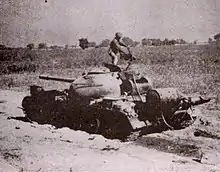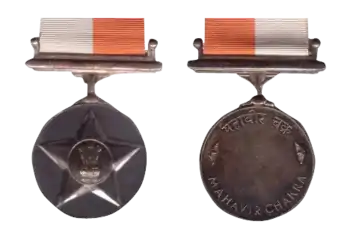| Battle of Hussainiwala | |||||||
|---|---|---|---|---|---|---|---|
| Part of Indo-Pakistani War of 1971 | |||||||
 Pakistani soldier standing on a knocked Indian tank during the Battle of Hussainiwala in the Sulemanki sector. | |||||||
| |||||||
| Belligerents | |||||||
|
|
| ||||||
| Commanders and leaders | |||||||
|
|
| ||||||
| Units involved | |||||||
|
Support: |
Support: | ||||||
| Strength | |||||||
| 900 | 2,000 | ||||||
| Casualties and losses | |||||||
| 125 total casualties | 99 total casualties | ||||||
The Battle of Hussainiwala was fought between India and Pakistan in the village of Hussainiwala as part of the western front of the Indo-Pakistani War of 1971. After fierce fighting, Hussainiwala was captured on 4 December 1971 by the 106th Infantry Brigade of the Pakistani Army, and the defending Indian 15 Punjab unit retreated with heavy losses.
Prelude
The Indo-Pakistani War of 1971 broke out on 3 December 1971 upon the launch of Operation Chengiz Khan by the Pakistan Air Force to carry out preemptive strikes on Indian Forward operating base targets and Radar installations. Upon the outbreak of war, would see the Pakistani II Corps begin an offensive into Punjab aimed at Ludhiana and Bhatinda.[3]
Pakistani order of battle
As part of Operation Chengiz Khan, the 11th Infantry Division (Pakistan) under Lieutenant General Majeed Malik would be responsible for activities in the Kasur District, while the 52 Brigade would be deployed to advance into Khemkaran.[4] The 106 Brigade under the command of Brigadier Mohammad Mumtaz Khan would capture the village of Hussainiwala. The 106 Brigade consisted of the Three Punjab, Nine Punjab, and the 41 Baloch. The 45 Field Regiment Artillery would provide artillery support.[4]
Indian order of battle
The Indian defense at Hussainiwala was solely composed of the 15 Punjab under the command of Lieutenant Colonel Shastry. The 15 Punjab had begun planning the defense of Hussainiwala in February 1971, especially the defense of the headworks. Three border security companies were assigned to hold the border outposts as well as the arrival of one field regiment for artillery support. The 15 Punjab was also provided with one squadron of armor.[5] Over the next six months, minefields would be laid alongside the construction of fortifications along the border posts.[5]
Battle
On 3 December with the outbreak of the war, the 106 Brigade had planned a two phased attack in three prongs. The 41 Baloch was to advance onto the Kaiser-e-Hind Fortress, while the 3 Punjab was to move to secure the perimeter along the headwaters at Hussainiwala. The 106 Brigade had begun their advance onto Hussainiwala at 6:15 PM on December 3 with a 15-minute artillery barrage by the 45 Field Regiment Artillery.
Major General Sukhwant Singh stated in his book India's War since Independence, "The Pakistani plan envisaged a three-pronged attack, with one thrust along the main road axis through the barrier, the second from the south towards the mouth of the bridge over the perimeter-defended locality, and the third from the northwesterly direction overrunning the BOPS."
The B Company (Three Punjab) ran into minefields planted by the 15 Punjab during their advance but continued on despite heavy enemy fire.[4] At 6:30 PM, the 41 Baloch crossed the Dipalpur Canal, while A Company (Three Punjab) advanced through the minefields despite heavy casualties and the loss of their commander, Major Muhammad Hanif. Waves of Pakistani attacks persisted throughout the night, however halting at the Bhagat Singh Memorial. The Memorial changed hands twice as Major SPS Waraich (Commander of the Indian Barriers at the Memorial) halted the Pakistani advance.[5] Major Ashraf Khan of the 41 Baloch had arrived at the Hussainiwala headwaters after crossing the Dipalpur Canal with heavy casualties, as he cut off Indian resistance along the perimeter of the headwaters. The Four Cavalry arrived as armored support for the 41 Baloch to diminish and capitulate remaining Indian resistance.[4][6]
December 4
As the morning of the 4 December arrived, the Indian Air Force provided air support with 24 sorties on the positions of the 41 Baloch. In this attack, Major Ashraf Khan was severely injured.[4]
By the night of December 4, the resistance offered by the 15 Punjab was hopeless, as the Pakistanis had secured the Dipalpur Canal and the headwaters, and Hussainiwala was bound to fall. In order to prevent the complete extermination of the 15 Punjab, Lt. Colonel Shastry retreated from Hussainiwala.[5]
Aftermath
Upon the withdrawal of the 15 Punjab from Hussainiwala, the village fell to the Pakistani Army. The Pakistani Army would withdraw from both Hussainiwala and Kaiser-e-Hind on 17 December 1971.[7] The 15 Punjab is remembered today for their incredible stand against the enemy despite having the odds against them.[8]
Casualties
Only 17 personnel of the 15 Punjab were killed in action, while 3 officers, and 31 other ranks were wounded. 72 other ranks and 2 Junior commissioned officers were missing – a total of 125 casualties.[5] Total Pakistani losses were 99 personnel (KIA, WIA or MIA).[9]
Gallantry

The personnel of the 41 Baloch were awarded 5 Sitara-e-Jurat, 6 Tamgha-i-Jurat, and 1 Imtiazi Sanad for their gallantry and heroics during the Battle of Hussainiwala. The 15 Punjab became the second highest decorated battalion in the Indian Army, with its members receiving 8 Maha Vir Chakras, and 18 Vir Chakras.[8]

See also
References
- 1 2 3 4 5 Singh, Sukhwant. "1971 War: The Battle of Hussainiwala." Indian Defence Review, 9 Jan. 2017, www.indiandefencereview.com/interviews/1971-war-the-battle-of-hussainiwala/. Accessed 25 Nov. 2023.
- 1 2 3 4 5 6 7 8 9 10 11 12 Ahmad, Rifat Nadeem. "The Battle of Hussainiwala." Bol News, 7 Aug. 2022, www.bolnews.com/newspaper/national-nerve/2022/08/the-battle-of-hussainiwala/. Accessed 25 Nov. 2023.
- ↑ Gill, John H. (2003). An Atlas of the 1971 India - Pakistan War: The Creation of Bangladesh. National Defense University, Near East South Asia Center for Strategic Studies.
- 1 2 3 4 5 Ahmad, Nadeem (7 August 2022). "The Battle of Hussainiwala". Bol News. Retrieved 25 November 2023.
- 1 2 3 4 5 "1971 War: The Battle of Hussainiwala". Indian Defence Review. 2020-12-09. Retrieved 2023-11-25.
- ↑ Ahmed, Habib (2015). The battle of Hussainiwala and Qaiser-i-Hind: the 1971 war (1 ed.). Karachi: Oxford University Press. ISBN 978-0-19-906472-4.
- ↑ Saikia, Yasmin (2017-07-03). "The Battle of Hussainiwala and Qaiser-i-Hind: The 1971 War". Journal of Military History. 81 (3): 932–934.
- 1 2 Shorey, Anil (2005). A Legendary Force, 1st Patiala: 300 Years of 15 Punjab (Patiala). Manas Publications. ISBN 978-81-7049-246-7.
- ↑ Siddiqi, Muhammad Ali (2015-02-08). "REVIEW: The Battle of Hussainiwala". DAWN.COM. Retrieved 2023-11-25.